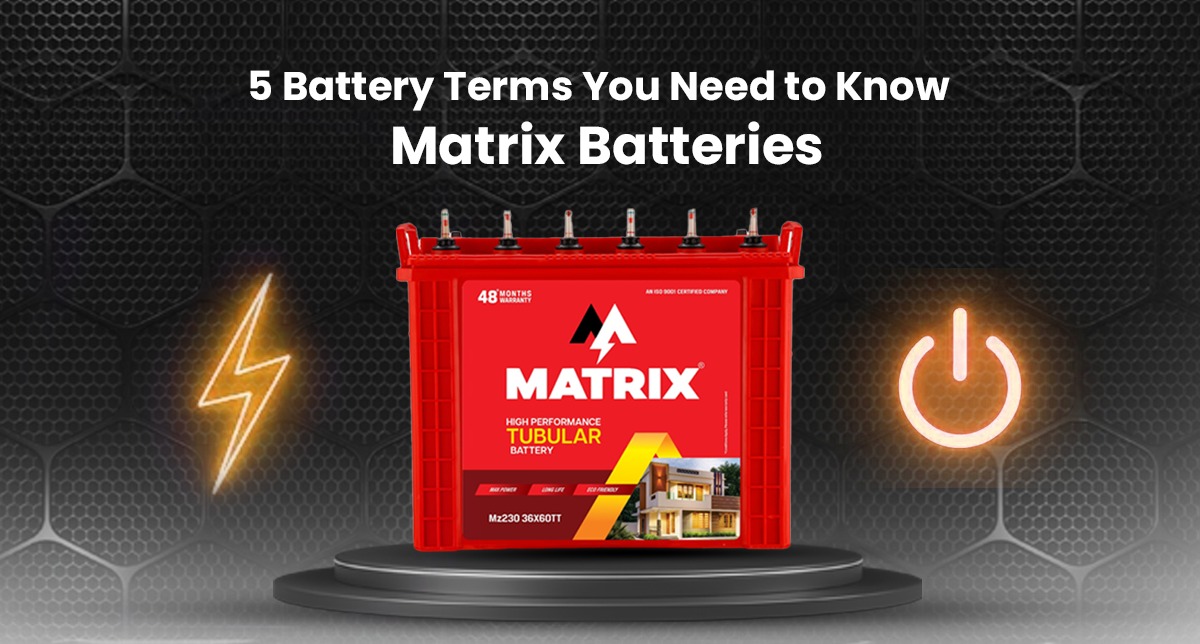Whether it’s a car, inverter, solar system, or an electric vehicle, batteries are the unseen force behind consistent performance. However, when customers compare products, they are often presented with technical terms that seem intimidating. At Matrix Batteries, we feel that every customer deserves to know the most important battery jargon—not just to choose the right product but also to know how it will perform in real life.
Here are five key battery terms that are most important:
Ampere-Hour (Ah) – Capacity Understanding
The Ampere-Hour rating indicates the amount of charge a battery will deliver over time. It is like the “fuel tank capacity” of your battery. For instance, a 150Ah inverter battery will supply 150 amps for one hour, 15 amps for 10 hours, or 1.5 amps for 100 hours, depending on load. A larger Ah rating provides longer backup and increased endurance in power outages. That is why selecting the appropriate Ah according to your home or business load is imperative.
Why it matters: Proper Ah sizing avoids repeated discharge cycles and prolongs battery life overall.
Cold Cranking Amps (CCA)
CCA is an important specification for car batteries. It determines the capacity of a battery to crank a cold engine at 0°F (–18°C) for 30 seconds at the minimum voltage. To put it simply, it informs you of your battery’s functionality during severe climate, particularly cold climate, conditions. The higher the CCA rating of your battery, the better the guaranteed start, improved ignition, and reduced starter motor load on your vehicle.
Why it matters: Even in warm climates of Southern India, CCA is significant since it indicates the initial power and internal capability of the battery.
Depth of Discharge (DoD) – How Much You Use
Depth of Discharge informs you what proportion of a battery’s capacity has been utilized before it will be recharged. As an example, utilizing 50Ah of a 100Ah battery is 50% DoD. While car batteries are meant for shallow discharge, solar and inverter batteries are deep-cycle batteries that can deal with deeper discharges without harming the battery. Nevertheless, frequent discharging below specified ranges can decrease battery lifespan.
Why it matters: Keeping Depth of Discharge within safe margins guarantees longer cycle life and uniform performance.
Cycle Life – Endurance Over Time
A cycle is a single discharge and recharge of a battery. Cycle life is a measurement of how many such cycles the battery will provide before its capacity falls below 80% of its new rating. For instance, a good deep-cycle battery will provide 1,200–1,500 cycles at 50% DoD.
Why it matters: Increased cycle life eventually leads to greater durability, cost savings, and dependability—making it a benchmark for solar, inverter, and EV batteries where daily cycles are the norm. Matrix Batteries are designed with cultivated plate design and additives to enhance cycle life.
Self-Discharge – Power Lost at Rest
Even when idle, batteries naturally lose a small portion of their charge. This is called self-discharge. Self-discharge rates usually increase in hot climates for lead-acid batteries, while lithium batteries have significantly lower rates. Battery needs to be recharged over and over again, when it tends to get discharged very fast. The increasing self discharge rate leads to wastage of electricity as well as reduces the overall life of the battery.
That’s why low self-discharge is so important — it means the battery stays ready to use even after long shipping or storage. Whether you’re a dealer, an exporter, or an everyday user, a low self-discharge battery saves time, energy, and money. Matrix Batteries are specially designed with proprietary chemistries to maintain low self-discharge so that they stay efficient even with long periods of inactivity or when not used.
Final Thoughts from Matrix Batteries
Being familiar with these five terms about batteries —Ampere-Hour, Cold Cranking Amps, Depth of Discharge, Cycle Life, and Self-Discharge—enables you to make smarter battery choices. At home, it means steady backup power; for drivers, it means smooth starts every time; and for businesses, it means reduced costs and increased efficiency.
At Matrix Batteries, we don’t just produce batteries—we deliver energy solutions engineered for performance, durability, and trust. We employ the most current technology and user-focused design to make power simple to understand and dependable to use.
Matrix Batteries – Power. Performance. Peace of Mind.


